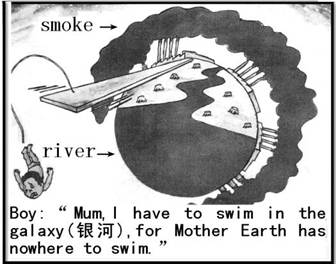
第三节书面表达(20分)
下图描述的是全球环境问题。请仔细观察这幅漫画,用英语写一篇短文,阐明漫画中所反映的问题,并提出解决此问题的方法(至少三点)。
注意:
1.仔细品味图中文字的韵味,可以适当发挥想象,不要做简单描述;
2.词数150个左右。开头已经写好,不计入总词数;
3. 作文中不得提及考生所在学校和本人姓名。
From the picture, we can see that pollution is posing a threat to our earth, which comes in many ways.
_______________________________________________________________________________
One possible version:
From the picture, we can see that pollution is posing a threat to our earth, which comes in many ways. Millions of chimneys of the factories are pouring heavy smoke into air, which causes serious air pollution. A large amount of waste water from the factories pollutes water, making our rivers fishless and our water unfit to drink and swim in. Furthermore, a lot of trees have been cut down without proper plans, which contributes to the soil being washed away. It seems that we really have no clean place to live.
The pollution is so serious that we have to find effective solutions to it. As far as I am concerned, the government should pass laws to reduce polluted air. Some measures should be taken to purify the water before it is poured into the rivers or the seas. We should plant more trees to keep the soil in place. What’s more, people should be further educated to realize the importance of environmental protection. Thus, we will have a clean and tidy environment.
